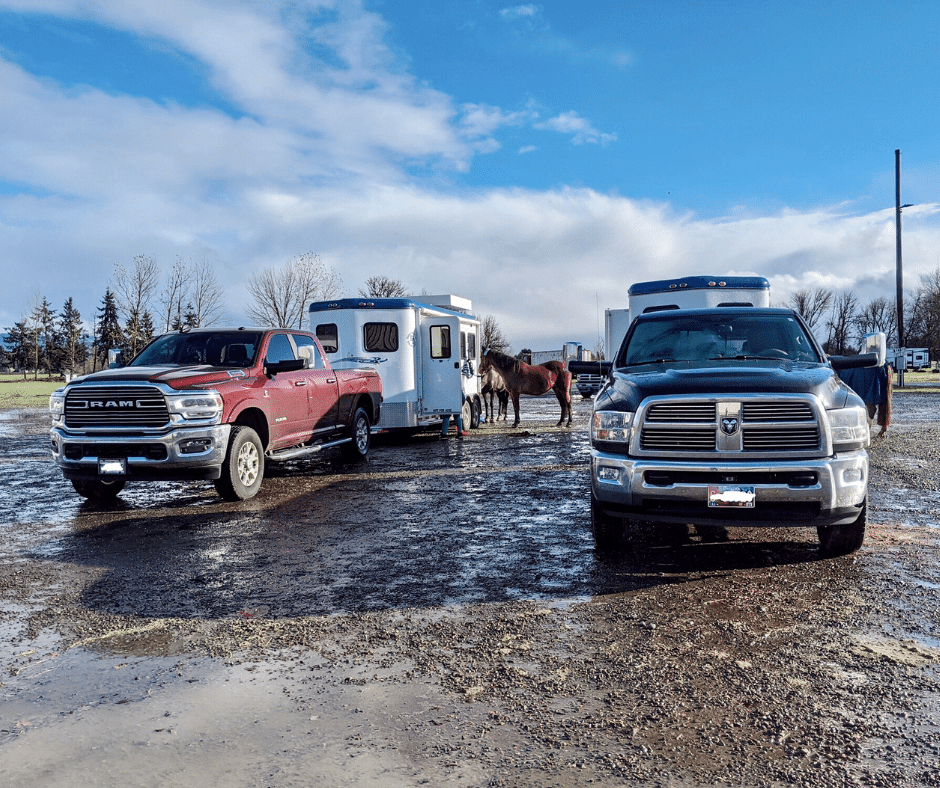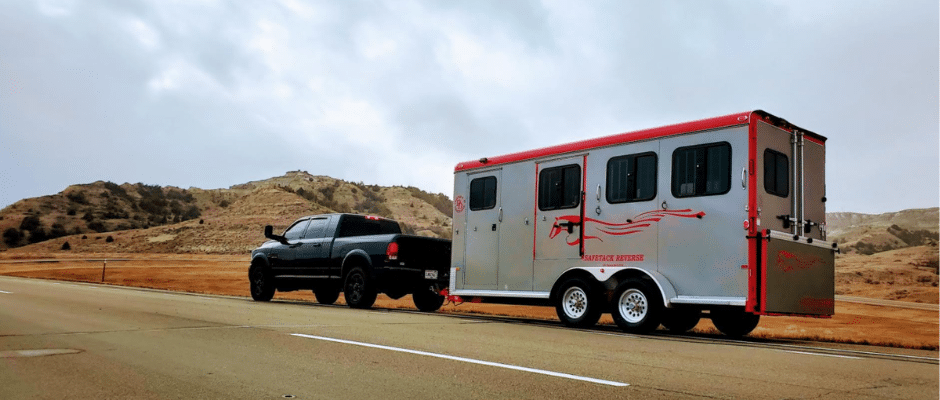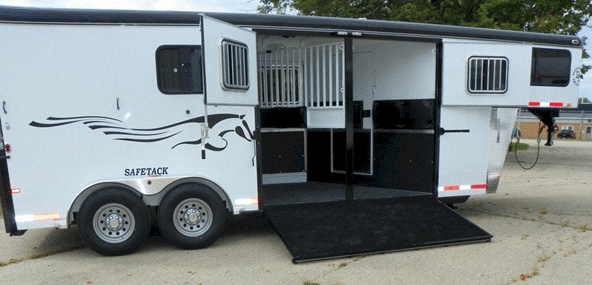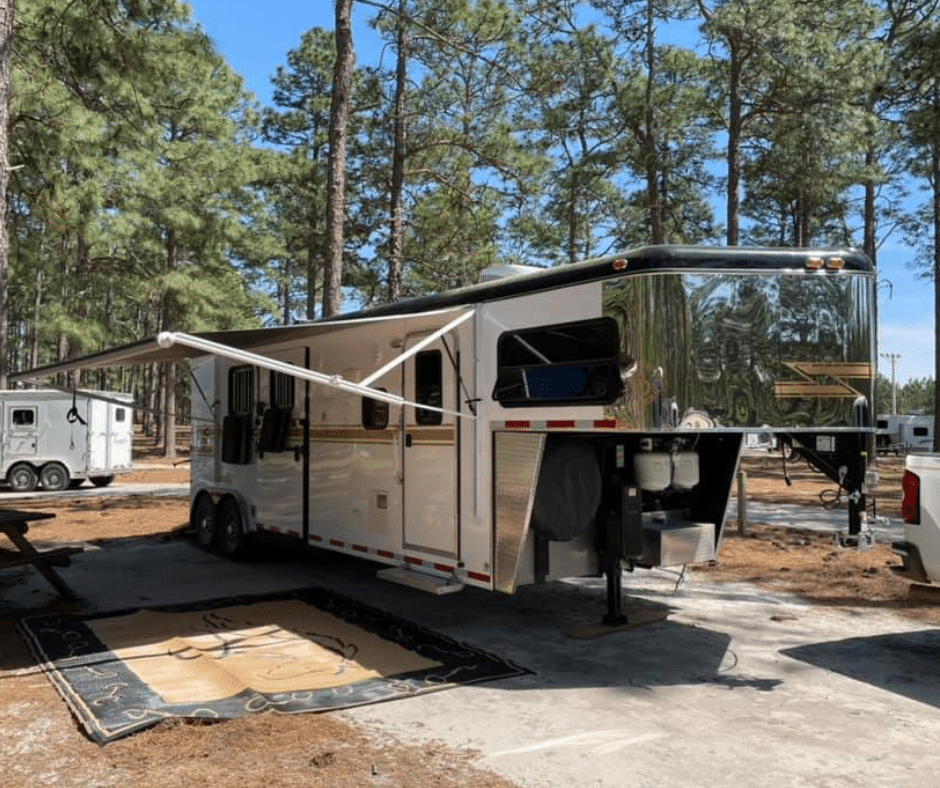Transporting Horses Across State Lines? Here’s What to Know…
There are many reasons why you are transporting horses across state lines. Competitions… horse shows… breeding… a new purchase…
 Regardless, proper preparation will make sure your horse arrives safely and happily in his new location. Sure, the process can be nerve-wracking, but there’s no reason you can’t learn how to transport a horse without issue.
Regardless, proper preparation will make sure your horse arrives safely and happily in his new location. Sure, the process can be nerve-wracking, but there’s no reason you can’t learn how to transport a horse without issue.
From important documents… to finding a horse motel… to hiring a professional driver… here are the important things to know when transporting your horse across state lines.
Documents You’ll Need When Transporting Horses Across State Lines
The exact documents you’ll need vary from state to state. So check your destination’s specific requirements by contacting the offices of state veterinarians at least 30-60 days before your travel date. Regardless of what they say, it’s a safe bet you’ll need at least this basic paperwork for transporting your horse across state lines.
#1. Negative Coggins
This test is performed by your vet and tests for Equine Infectious Anemia or EIA. It’s a blood virus that is extremely serious and contagious. Most farms, boarding facilities, and events will require proof of a negative Coggins test within the last 12 months. For some states, a copy won’t do and they’ll need the original documents. Be sure to check in advance. Also, other states require a more current test within the last 6 months.
#2. Certificate of Veterinary Inspection
This is a certificate issued by a licensed veterinarian that declares it safe for transporting horses across state lines. It may also be required if transporting a horse within the same state more than 75 miles. It should include the origin state, states you’ll pass through on your trip, and the final destination state. The certificate should be issued within 30 days of the travel arrival.
#3. Brand Inspection Card
This verifies ownership of a horse and is most important if traveling through states in the western part of the country. You may need this card even if your horse isn’t branded.
#4. Passport Health Certificate
Some states have a predetermined agreement that allows the transporting of horses across state lines within their states for a 6 month period. Think of it like a universal passport that a network of countries have agreed to honor.
Two Methods for Transporting Horses Across State Lines
When planning your trip, there are two main options for transporting a horse:
1) You could hitch up your own truck and do the horse trailer shipping yourself.
2) Or, you could hire a commercial or independent shipper to transport your horse via ground or air.
Either way, take precautions to prevent shipping fever – an infection of the lungs and pleural cavity caused by a lowered immune system and too much dust in the horse’s airway during travel. Read this article to learn everything you need to prevent shipping fever in horses.
#1: Horse Trailer Transport with a Personal Trailer
If you choose horse trailer transport using a personal horse trailer, you’ll be solely responsible for the safety and comfort of your animals. We wrote an article about how to transport a horse long distance with a detailed list of what you should consider before your trip. Or, read a quick summary here:
- Make sure the trailer maintenance is up-to-date and the tires are good.
- Pack hay and water for your horse to have during the trip.
- Provide electrolytes the day before travel to hydrate your horse.
- Learn how to properly protect your horse’s legs with wraps or shipping boots.
- Practice loading and unloading from the horse trailer.
- Plan rest stops every 2-3 hours – unload if possible and check horse vital signs.
- Offer water at every rest stop.
- Tie your horse so he is able to lower his head enough to snort out dust and debris.
- Be aware of the weather during your trip. Don’t put too many blankets on so that your horse sweats and also keep him well hydrated.
Trailer Safety Features to Keep Your Horse Protected During the Journey
The most important thing is that your trailer is well suited to protect your horse. Make sure there is proper ventilation by considering the windows, overhead air vents, and tubular head dividers. This will help regulate the temperature in the trailer so it doesn’t get too hot – causing dehydration. Proper building materials like a SafeBump roof, insulated walls, and Rumber flooring will also maintain a safe temperature.
A slant load trailer with padded Z-frame dividers will keep him supported in his stall. Then, consider a reverse load trailer which allows for less stress and fatigue on your horse during travel. Finally, think about the stress your horse experiences loading and unloading. A wide open trailer with the SafeTack layout (pictured below) will ease the loading process, and reduce stress (which keeps your horse’s immune system strong during travel.)
Looking for Places to Rest Overnight and Horse Motels
When looking for places to rest with your horse, consider stopping at horse rest stops, stables, and fairgrounds. Resources like the Equine Info Exchange can give you a directory of horse motels and overnight boarding facilities. This list is organized by state.
You might also find places for horse camping at places like:
- Bureau of Land Management www.blm.gov
- National Park Service www.nps.gov
- National Forest Service fs.usda.gov
How to Sanitize Your Overnight Horse Lodging
If you keep your horse at a public boarding facility overnight, you’ll want to protect against any diseases in that location. Here are some basic steps to take:
- The stalls should be cleaned and disinfected
- Wash buckets, hay racks, mangers, troughs, walls, cross ties, etc.
- Bring your buckets from home if possible.
- When cleaning, use dilute chlorhexidine (available on Amazon and at tack stores) or dilute household bleach.
If you do clean equipment rather than bringing your own, be careful the cleaning materials don’t leave a smell. Bleach used in buckets could leave an odor that prevents your horse from drinking.
#2: Horse Trailer Shipping Using a Commercial or Independent Shipper
Sometimes it’s not possible to transport your horse in a personal trailer. In this case, it might make more sense to hire a commercial or independent shipping company. Sites like Move My Horse can help you find a good carrier. These companies should be insured and trained to safely transport horses. They may offer you a few stall size options including 1) full stall, 2) stall and a half, or 3) full box stall.
Some commercial horse shippers will only travel certain routes common between racetracks and horse shows. They might require a full load to make the main part of the journey. This could mean your horse is on the trailer longer than purely necessary. It’s like the kid who gets stuck on the late school bus and has to travel an hour longer just so the other kids can get dropped off first.
Independent shippers either own their own truck or trailer or they will drive your truck and trailer with your horse. Check to make sure they are properly insured and competent. The good news is: an independent shipper can usually make the journey more direct (faster) and provide more personalized attention to your horse.
How to Find a Reputable Horse Hauler
If possible, get a recommendation for a horse hauler from a friend or trainer. Or, ask for references and photos for the truck and trailer in advance. Above all, look for very strong communication skills. You are trusting this person or company with your very valuable and beloved horse, so they should be willing to answer ALL of your questions well in advance.

- Horse trailer shipping rates will vary so do your research and pick the best option for your circumstances. You may pay anywhere from $0.75 to $3.00 per mile with extra fees for layovers.
- Veterinary fees for your horse during travel will be billed to you.
- Get insurance on your horse.
- Find out how long your horse will be on the trailer.
- Check to make sure your horse will have enough space for his size and can lower his head to snort out dust and debris (a common cause of shipping fever).
- Make sure you have the driver’s contact information and delivery date confirmed.
Here are a few more questions to answer before trusting a shipping company:
- Have the trucks and trailers been inspected for safety?
- How much space will your horse have?
- Are the truck and trailer regularly cleaned and sanitized?
- Is there enough air ventilation?
- How will your horse be tied up? Can he lower his head to snort out dust and debris?
- Are the handlers experienced in working with horses?
- How often will the horses get hay and water?
- How often will they take rest stops?
- Is there more than one driver who can take over?
- Are veterinarians available if needed?
- Is there a first aid kit on the trailer and is the driver trained to provide first aid?
Transporting a Horse by Air
Have you ever thought about how elite racehorses and show horses travel abroad? Well, air travel for horses is something that has been around since the 1960’s. If you have to travel overseas or a long way over ground, then it makes sense to book a ticket for your horse on an airplane. The cost for international air transportation will be between $2,000 and $10,000 for a one-way flight.
You’ll need a company that specializes in equine air transport. Companies like H.E. Tex Sutton and even FedEx are known to be reliable options. Learn more about transporting your horse via air on Horseflight.
Monitoring Your Horse After Arrival
Once you’ve arrived with your horse at your new destination, make sure he settles in nicely. Let your horse free in a paddock or give them a good walk around to stretch their legs. Give them enough time to rest and recover before asking them to do strenuous exercise. Monitor their food and water intake and take their rectal temperature daily. Look out for signs of shipping fever and look for any weight loss.
Frequently Asked Questions
How much does it cost to transport a horse?
The cost will vary depending on how you transport your horse. An average estimate is $2.55 per mile for trips less than 100 miles or $1.10 per mile for trips over 100 miles. The range of fees is between $0.75 per mile to $3.00 per mile with extra changed for layovers, which are $150 to $300 per day. International flights cost between $2,000 and $10,000 for a one-way flight.
How to transport a horse across country?
You could either transport a horse across country by land or by air. Commercial and independent shipping companies charge between $0.75 and $3.00 per mile. An international flight will cost $2,000 to $10,000 for a one-way ticket. If you transport your horse in a personal trailer, make sure you plan for rest stops, pack the correct supplies, and have all the health documents to travel from state to state.
What do you need to cross state lines with a horse?
Every state has different requirements so make sure you double check. At the minimum, you’ll need a negative Coggins (EIA) test within 12 months and a Certificate of Veterinary Inspection. Some states require a Brand Inspection Certificate, a Passport Health Certificate, or other documents in addition.
What vaccines do horses need to cross state lines?
The most important document you’ll need is proof of negative Coggins which tests for Equine Infectious Anemia (EIA.) This is a very serious virus that is highly contagious and has no vaccine and no cure. You’ll need a proof of Coggins within the last 12 months and possibly within a shorter timeframe (like 6 months) for some states.



